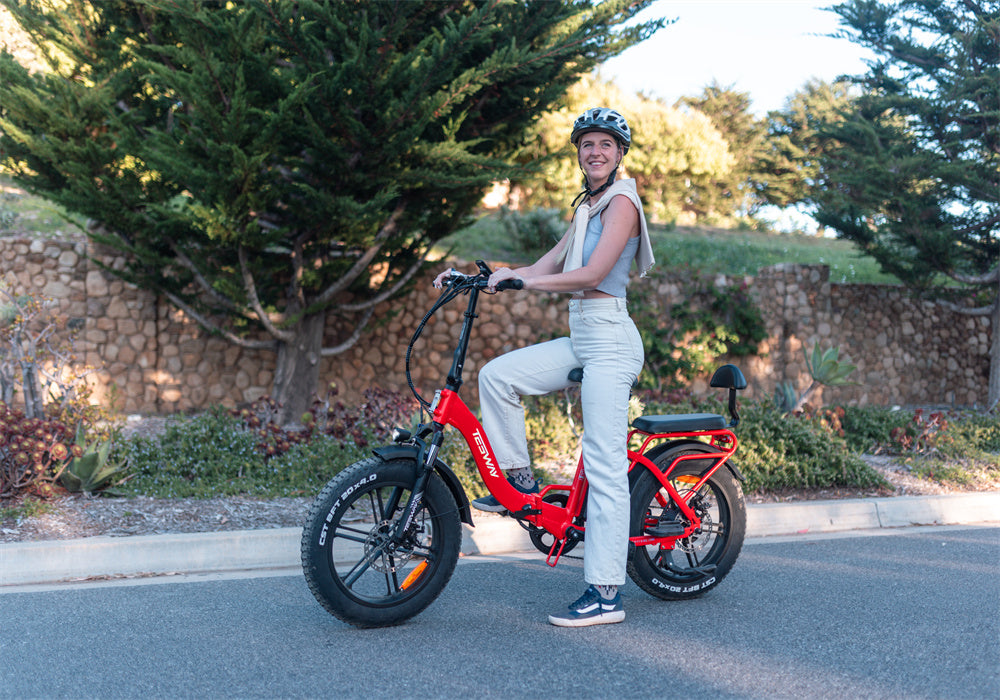Fat tire ebikes, characterized by their substantial, wide tires that are generally 3.8 inches or broader, represent a unique category in the realm of cycling. These bikes are built with rims that are at least 2.6 inches wide, specifically designed to support the girth of the tires.
The primary allure of fat tire bikes lies in their exceptional stability and enhanced traction, which prove invaluable on a variety of challenging terrains, such as snowy paths, sandy beaches, and even boggy trails.
The innovative tire design significantly alters the distribution of a rider’s weight across a larger area, which not only helps prevent sinking on softer surfaces but also contributes to a smoother ride over bumps and dips, making them ideal for adventurous cyclists seeking to conquer diverse landscapes.

Physics of Pedaling Fat Tire Bikes
The act of pedaling a fat tire electric bike requires a different approach due to the intrinsic physical characteristics of the bike:
Rolling Resistance: The primary challenge with fat tire bikes is the increased rolling resistance, a direct consequence of the tires' extensive contact with the ground. This resistance is due to the larger footprint of the tires, which increases friction and thus the energy required to maintain speed. Unlike traditional tires, fat tires are often inflated to much lower pressures—usually between 5 and 20 PSI (as opposed to 40-70 PSI in standard mountain bikes)—which exacerbates this issue by increasing the tires’ surface contact and deformation during rides.
Aerodynamic Drag: Beyond rolling resistance, fat tire bikes suffer from increased aerodynamic drag. The bulky tires coupled with a typically upright riding position result in a significant drag, making it harder to pedal at higher speeds, particularly in windy conditions.
Weight Factors: The weight of fat tire bikes is also a considerable factor. The heavier tires require robust frames and rims, adding to the overall mass of the bike. This additional weight demands more power from the cyclist to achieve and maintain momentum, particularly noticeable when accelerating or climbing hills.

Optimizing for Terrain and Conditions
Despite the challenges, fat tire bikes are specifically optimized for environments where thinner tires would falter:
Soft Terrains Like Snow and Sand: One of the standout features of fat tires is their ability to navigate through soft terrains with ease. The broad tires distribute the bike’s weight over a larger area, reducing the likelihood of sinking into soft ground like snow or sand, which can be problematic for standard bike tires.
Rugged Trails: On uneven and rocky trails, the large volume of fat tires plays a pivotal role. They act like natural shock absorbers, cushioning the ride by dampening vibrations and absorbing harsh impacts that would typically be felt by the rider. This attribute not only enhances comfort but also reduces the physical strain on both the bike and rider, allowing for longer and more enjoyable rides.
Stability and Traction: The increased width and surface area of fat tires deliver superior stability and grip, particularly on slippery or uneven surfaces. This enhanced traction allows for better control of the bike, making it easier to handle in challenging conditions and reducing the risk of accidents.

Comparative Pedaling Dynamics with Standard Bikes
When compared to standard bicycles, fat tire bikes offer a distinct set of advantages and challenges.
Fat tire bikes inherently require more energy to pedal due to the factors discussed, such as higher rolling resistance and additional weight. This can lead to quicker fatigue, particularly on longer rides or when navigating terrain that doesn't play to the strengths of fat tires.

Typically, fat tire bikes perform at reduced speeds on paved surfaces due to their inefficiencies. The drag and weight make them slower compared to road or standard mountain bikes, which are optimized for speed and agility on smoother surfaces.
Although they may be slower on conventional terrains, fat tire bikes shine in their ability to adapt to diverse and challenging environments. This adaptability makes them the bike of choice for riders looking to explore areas beyond the reach of traditional cycling equipment, offering the freedom to venture into nature's more rugged landscapes.

Riding the TESWAY S7 Fat Tire Electric Bike Was Effortless
When I first got on the TESWAY S7 fat tire electric bike, I was a bit skeptical about how it would handle, especially with those massive tires. But to my surprise, it was a breeze to ride! The 750W motor really does the heavy lifting, making pedaling almost effortless. Even on steeper inclines where I expected to struggle, the bike just powered through without requiring much effort from me at all.
The battery life on this bike is nothing short of impressive. I could ride up to 110 miles on a single charge, which is way more than enough for my daily commutes and even some leisurely explorations on the weekends. I didn’t have to worry about running out of juice halfway through my rides, which was a huge relief.

Speed is another area where the TESWAY S7 shines. It can reach up to 28 mph, which is quite fast for an electric bike. This made getting to my destinations quicker and more fun, with the wind whipping past and the bike smoothly handling the pace.
As for carrying capacity, the bike holds up to 330 lbs, which is robust by any standard. I could easily carry my backpack, groceries, and sometimes even an extra load without feeling any drop in performance or stability.
And let's talk about the seat—TESWAY really nailed it with the wide seat cushion. It's honestly the most comfortable bike seat I've ever used. After learning that TESWAY tested many materials to find this one, I can see why they chose it. Long rides are a breeze with this kind of comfort.

One feature I particularly loved was the special pattern design on the fat tires. It significantly increased the bike’s grip on the ground, making me feel extra secure, even on slippery or rough surfaces.
Overall, riding the TESWAY S7 was an excellent experience. It combines the rugged utility of a fat tire bike with the ease and convenience of an electric bike. Definitely not difficult to ride at all – instead, it was an absolute joy!
FAQs
Are fat tire bikes good for everyday use?
Fat tire bikes are excellent for recreational use and off-road adventures but may be less efficient for daily commuting on paved roads due to their increased rolling resistance.
Can fat tire bikes be used on paved roads?
Yes, while they are designed for off-road conditions, fat tire bikes can certainly be used on paved roads, though they are not as efficient as road bikes in this environment.
What pressure should fat tires be inflated to?
Fat tires are typically inflated to pressures ranging from 5 to 30 PSI, much lower than standard bike tires, to maximize their traction and comfort on uneven terrains.







Share:
E-Bike Batteries: Everything You Need to Know
Big Benefits of Fat Tire Bikes for Your Next Outdoor Adventure